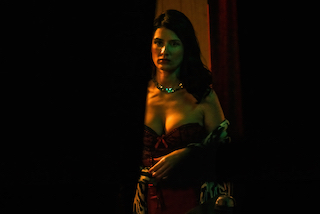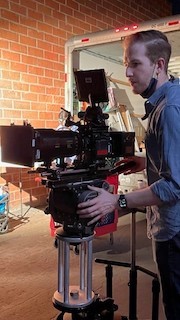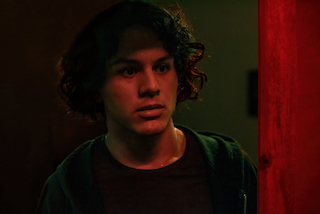 For Proof Sheet, cinematographer Jonathan Pope and director Richard Kilroy discussed references and inspirations for a film set in 1999 Los Angeles and the challenges of hiding 2023 Los Angeles. Taking place between Christmas and New Year’s Eve, the noir film Proof Sheet tells the story of a beautiful woman in trouble and an incriminating roll of film that sends a photo-lab worker on an investigation into a dark world of sex, secrets, and murder.
For Proof Sheet, cinematographer Jonathan Pope and director Richard Kilroy discussed references and inspirations for a film set in 1999 Los Angeles and the challenges of hiding 2023 Los Angeles. Taking place between Christmas and New Year’s Eve, the noir film Proof Sheet tells the story of a beautiful woman in trouble and an incriminating roll of film that sends a photo-lab worker on an investigation into a dark world of sex, secrets, and murder.
“In many ways, the film is a noir. So, we drew on classics like Heat, The Conversation, and Double Indemnity for inspiration, really playing with light and shadow,” said Pope. “We used a mix of natural sources of light – practicals and streetlights – augmented predominantly with LEDs such as the Hudson Spider, Arri Skypanels, Litegear Litemats, and Astera Titan tubes that are easy to hide and run remotely for little pockets of light.”
 Early on, Pope and Kilroy selected anamorphic as the format of choice for Proof Sheet. Pope knew exactly what lenses he wanted: Cooke. “The Cooke anamorphics are not aggressive like some other anamorphics can be. The Cooke Anamorphic/i has subtle edge distortions, beautiful flares, smooth bokeh, nice contrast retention, and an overall organic quality that I am incredibly drawn to. I’ve used them on numerous projects, including music videos and The Social Dilemma, all of which reinforced my love for them.”
Early on, Pope and Kilroy selected anamorphic as the format of choice for Proof Sheet. Pope knew exactly what lenses he wanted: Cooke. “The Cooke anamorphics are not aggressive like some other anamorphics can be. The Cooke Anamorphic/i has subtle edge distortions, beautiful flares, smooth bokeh, nice contrast retention, and an overall organic quality that I am incredibly drawn to. I’ve used them on numerous projects, including music videos and The Social Dilemma, all of which reinforced my love for them.”
“I’ve been using Cooke lenses for years,” said Pope. “I’ve always been drawn to the beautiful ways in which they render an image, with warmth and subtle softness, the Cooke Look. Plus, the outstanding build quality – durability and reliability – for heavy duty production work is something I rely on.”
So strong was Pope’s desire to use Cooke Anamorphic/i primes, that he didn’t test them against other anamorphic lenses for Proof Sheet. “I knew the look that Richard wanted, and I knew how to achieve it. So, I pulled some tests that I had done for previous projects, combined them with my knowledge of how the Cookes would look, and sold that to him.”
Shot predominantly on both a Red Epic-W Gemini 5K – built for extreme low light situations – and a Red Monstro 8K Monstrochrome – which takes full advantage of the camera’s sensor as opposed to removing the chroma from the Gemini camera image – with finishing in 4K. Pope’s 2x Anamorphic/i kit consisted of the 25mm, 32mm, 50mm, 65mm Macro, 100mm, and 135mm all rented from The Cameria Division in Los Angeles.
 “The 65mm Macro quickly became one of our go-to lenses throughout production,” said Pope. “Given that our protagonist unravels the central mystery through photos and other small clues, having the ability to capture macro imagery was crucial. Simultaneously, we were working on a tight schedule. So, having a lens that could serve multiple functions was a real blessing. The 65mm Macro was the perfect medium - not too wide, not too long, and the falloff makes it feel intimate. This versatility allowed us to accomplish shots where the plane of focus changed from a long distance to just inches from the lens. All of this, while wide open at a T2.6 without any loss in clarity was stunning and a real testament to the Cooke team.”
“The 65mm Macro quickly became one of our go-to lenses throughout production,” said Pope. “Given that our protagonist unravels the central mystery through photos and other small clues, having the ability to capture macro imagery was crucial. Simultaneously, we were working on a tight schedule. So, having a lens that could serve multiple functions was a real blessing. The 65mm Macro was the perfect medium - not too wide, not too long, and the falloff makes it feel intimate. This versatility allowed us to accomplish shots where the plane of focus changed from a long distance to just inches from the lens. All of this, while wide open at a T2.6 without any loss in clarity was stunning and a real testament to the Cooke team.”
“One of my favorite shots in the film is actually one of the simplest,” Pope said. “Late in the film, we cut to a medium closeup of our protagonist as he witnesses a puzzling new piece of evidence out of frame. When we got to this shot, the wind was gently blowing his hair and the sun was setting just behind his head. As he naturally moved from side to side, the sun would gently flare the lens, obscuring his face. Thanks to the unique cross-shaped flare that the Cooke Anamorphic/i’s produce, it felt truly magical and encapsulated this important story beat with a poignant visual. An added benefit of the lenses is Cooke’s i/Technology, which provided crucial on-screen metadata that my ACs and our script supervisors were able to utilize.”
“I’m generally not drawn to images that are overly crisp, as they can often feel a bit sterile to me. I love images that have character, depth, and textures,” explained Pope. “From the beginning, Richard and I wanted to emulate a ‘film’ look as much as possible. So, in conjunction with the Cooke lenses, I employed a 1/2 Glimmerglass filter for most scenes. This added a subtle highlight bloom which helped to emulate the halation of highlights often produced when shooting on film and got us one step closer to achieving a look that we felt was appropriate for our 1999 setting.”
